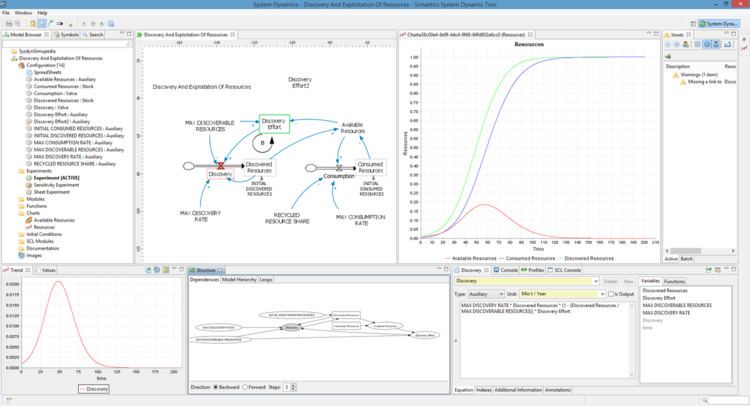Developer(s) Simantics Team Development status Active | Stable release 1.9.0 Operating system | |
 | ||
Initial release January 2012; 5 years ago (2012-01) Written in Java (programming language) | ||
Simantics System Dynamics is a ready-to-use system dynamics modelling and simulation software application for understanding different organizations, markets and other complex systems and their dynamic behavior.
Contents
Simantics System Dynamics is used for modeling and simulating large hierarchical models with multidimensional variables. The models are created in a traditional way with stock and flow diagrams and causal loop diagrams. Simulation results and the model structure can be analyzed with different visual tools.
Simantics System Dynamics is developed on the Simantics Platform and is released under Eclipse Public License and provided as an open-source software.
History
The development was initiated by a group of active system dynamics modellers who had needs and ideas for an open toolset. The new needs for features like hierarchical modules, module libraries, collaborative model development and efficient model communication in system dynamics together with the development of open source modelling framework Simantics and simulation environment OpenModelica drove the developers to start developing an open source modelling and simulation software for system dynamics.
Features
Simantics System Dynamics has several key features
Interface and usability
Simantics System Dynamics (as any other Simantics based product) is built on top of Eclipse and therefore the User interface logic follows closely the one introduced in Eclipse.
Simantics System Dynamics workbench window contains one or more perspective and perspectives contain different views and editors. Views are used to represent data in different ways. Editors are used for the actual modeling.
Simantics Platform
Simantics is an open source software platform especially for modelling and numerical simulation. It is a grounding to build a modelling and simulation software or to integrate different software tools.
Simantics platform utilizes heavily semantic data driven technique. All the data in the Simantics platform database is described using semantic data models and ontologies. In addition to the database, Simantics platform contains many features and user interface elements that are common to most simulation and modelling tools like diagram editor, symbol library and different kind of experiment and state management.
